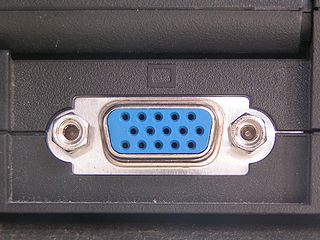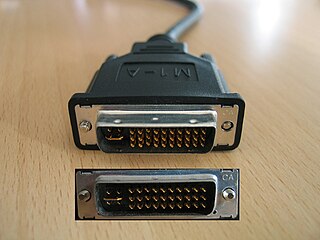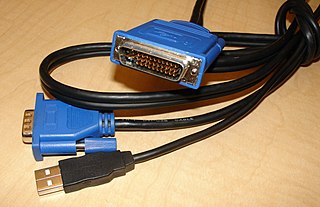
Digital Visual Interface (DVI) is a video display interface developed by the Digital Display Working Group (DDWG). The digital interface is used to connect a video source, such as a video display controller, to a display device, such as a computer monitor. It was developed with the intention of creating an industry standard for the transfer of uncompressed digital video content.

Video Graphics Array (VGA) is a video display controller and accompanying de facto graphics standard, first introduced with the IBM PS/2 line of computers in 1987, which became ubiquitous in the IBM PC compatible industry within three years. The term can now refer to the computer display standard, the 15-pin D-subminiature VGA connector, or the 640 × 480 resolution characteristic of the VGA hardware.

SCART is a French-originated standard and associated 21-pin connector for connecting audio-visual (AV) equipment. The name SCART comes from Syndicat des Constructeurs d'Appareils Radiorécepteurs et Téléviseurs, "Radio and Television Receiver Manufacturers' Association", the French organisation that created the connector in the mid-1970s. The related European standard EN 50049 has then been refined and published in 1978 by CENELEC, calling it péritelevision, but it is commonly called by the abbreviation péritel in French.

A graphics card is a computer expansion card that generates a feed of graphics output to a display device such as a monitor. Graphics cards are sometimes called discrete or dedicated graphics cards to emphasize their distinction to integrated graphics processor on the motherboard or the CPU. A graphics processing unit (GPU) that performs the necessary computations is the main component in a graphics card, but the acronym "GPU" is sometimes also used to erroneously refer to the graphics card as a whole.

Component video is an analog video signal that has been split into two or more component channels. In popular use, it refers to a type of component analog video (CAV) information that is transmitted or stored as three separate signals. Component video can be contrasted with composite video in which all the video information is combined into a single signal that is used in analog television. Like composite, component cables do not carry audio and are often paired with audio cables.
The Display Data Channel, or DDC, is a collection of protocols for digital communication between a computer display and a graphics adapter that enable the display to communicate its supported display modes to the adapter and that enable the computer host to adjust monitor parameters, such as brightness and contrast.

The D-subminiature or D-sub is a common type of electrical connector. They are named for their characteristic D-shaped metal shield. When they were introduced, D-subs were among the smallest connectors used on computer systems.
Apple Inc. has sold a variety of LCD and CRT computer displays. Apple paused production of their own standalone displays in 2016 and partnered with LG to design displays for Macs. In June 2019, the Pro Display XDR was introduced, however it was expensive and targeted for professionals. Nearly three years later, in March 2022, the Studio Display was launched as a consumer-targeted counterpart to the professional monitor. These two are currently the only Apple-branded displays available.

The SGI Indigo2 and the SGI Challenge M are Unix workstations which were designed and sold by SGI from 1992 to 1997.

The Apple Display Connector (ADC) is a display and data connector developed by Apple, Inc. as a proprietary modification of the DVI connector. ADC combines analog and digital video signals, USB, and power all in one cable. It was used in later versions of the Apple Studio Display, including the final 17" CRT model, and most versions of the widescreen Apple Cinema Display, after which Apple adopted standard DVI connectors on later models.

The Video Graphics Array (VGA) connector is a standard connector used for computer video output. Originating with the 1987 IBM PS/2 and its VGA graphics system, the 15-pin connector went on to become ubiquitous on PCs, as well as many monitors, projectors and high-definition television sets.

A KVM switch is a hardware device that allows a user to control multiple computers from one or more sets of keyboards, video monitors, and mice.

DisplayPort (DP) is a digital display interface developed by a consortium of PC and chip manufacturers and standardized by the Video Electronics Standards Association (VESA). It is primarily used to connect a video source to a display device such as a computer monitor. It can also carry audio, USB, and other forms of data.

DMS-59 was generally used for computer video cards. It provides two Digital Visual Interface (DVI) or Video Graphics Array (VGA) outputs in a single connector. A Y-style breakout cable is needed for the transition from the DMS-59 output to DVI (digital) or VGA (analogue), and different types of adapter cables exist. The connector is four pins high and 15 pins wide, with a single pin missing from the bottom row, in a D-shaped shell, with thumbscrews. As of December 2020, this adapter cable was listed as obsolete by its primary vendor Molex.

OpenLDI is a high-bandwidth digital-video interface standard for connecting graphics/video processors to flat panel LCD monitors. Even though the promoter’s group originally designed it for the desktop computer to monitor application, the majority of applications today are industrial display connections. For example, displays in medical imaging, machine vision, and construction equipment use the OpenLDI chipsets.

VESA Plug and Display is a video connector that carries digital signals for monitors, such as flat panel displays and video projectors, ratified by Video Electronics Standards Association (VESA) in 1997. Introduced around the same time as the competing connectors for the Digital Visual Interface and VESA's own Digital Flat Panel, it was marketed as a replacement for the VESA Enhanced Video Connector. Unlike DVI, it never achieved widespread implementation.

The VESA Enhanced Video Connector (EVC) is a VESA standard that was intended to reduce the number of cables around a computer by incorporating video, audio, FireWire and USB into a single cable system, terminating in a 35-pin Molex MicroCross connector. The intent was to make the monitor the central point of connection. The EVC physical standard was ratified in November 1994, and the pinout and signaling standard followed one year later.

The Dreamcast VGA Box is an accessory for Sega's Dreamcast video game console that allows it to connect to a video display such as a computer monitor or an HDTV set through a VGA port. Because the Dreamcast hardware can produce a VGA-compatible video signal natively, this connection provides improved picture quality compared to standard composite video or S-Video connections, along with support for progressive scan video.
Audio connectors and video connectors are electrical or optical connectors for carrying audio or video signals. Audio interfaces or video interfaces define physical parameters and interpretation of signals. For digital audio and digital video, this can be thought of as defining the physical layer, data link layer, and most or all of the application layer. For analog audio and analog video these functions are all represented in a single signal specification like NTSC or the direct speaker-driving signal of analog audio.



















